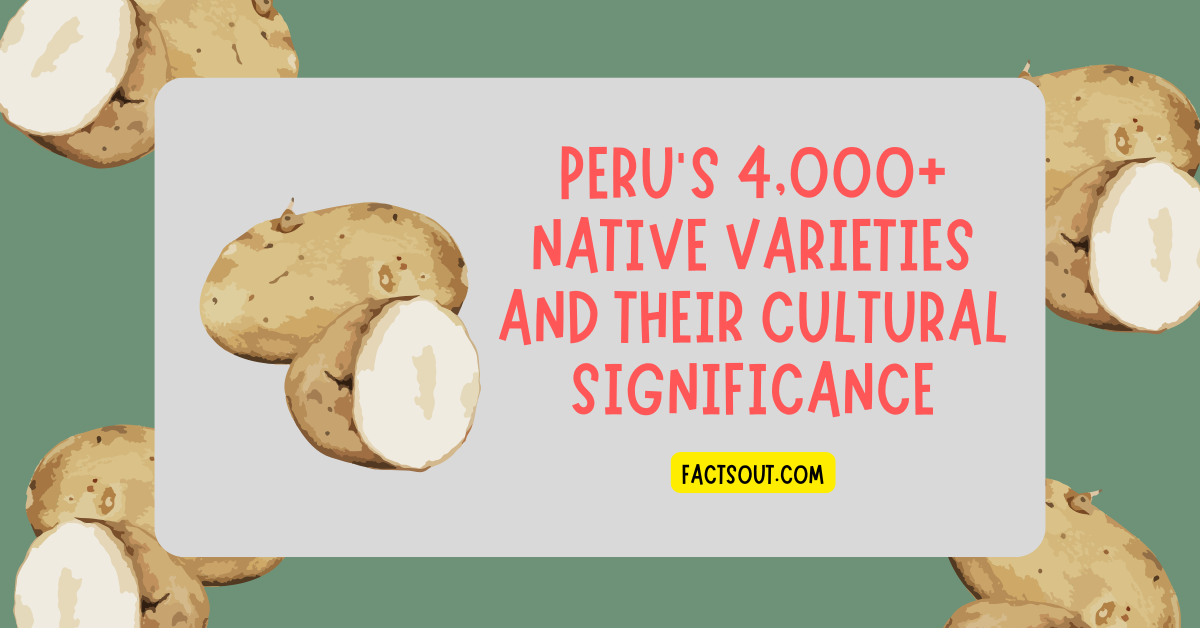When you think of potatoes, what comes to mind? French fries, mashed potatoes, maybe even vodka? But if you travel high into the Andes of Peru, you’ll discover a world where potatoes are far more than just a food staple—they’re a living cultural legacy, a symbol of biodiversity, and a key to climate resilience.
Peru is home to more than 4,000 native potato varieties, making it the epicenter of potato biodiversity in the world. These aren’t just different sizes or colors—each variety has its own taste, texture, growing pattern, and cultural story.
Let’s unearth the incredible story of Peru’s potato guardians and how this humble tuber helped shape the identity of an entire nation.
🇵🇪 Potato’s Birthplace: The Sacred Origins in the Andes
The Andean Highlands, especially in southern Peru and parts of Bolivia, are recognized as the cradle of potato domestication, dating back over 8,000 years.
🧪 Fun fact: Archaeologists have found potato remains in ancient Peruvian settlements, used not just for food but also for healing wounds and even predicting the weather!
From their spiritual importance to their resilience in harsh climates, potatoes have been central to Andean life for millennia.
🥔 4,000+ Varieties: Nature’s Living Library
Peru’s potato collection is mind-blowing in its diversity:
| Type of Potato | Description | Nickname/Notes |
|---|---|---|
| Papa Púrpura | Deep purple, antioxidant-rich | “The antioxidant queen” |
| Papa Amarilla | Yellow flesh, creamy texture | Used for mashed dishes |
| Papa Huayro | Bluish skin, firm and waxy | Great for salads and boiling |
| Papa Cacho de Toro | Horn-shaped, red-pink skin | Literally “bull horn potato” |
| Papa Qeqorani | Multicolored, spotted skin | Almost too pretty to eat! |
✨ Some varieties grow above 4,000 meters where few crops can survive. Others are resistant to frost, pests, or drought—built-in superpowers from thousands of years of evolution.
👨🌾 Meet the Guardians: Indigenous Farmers as Biodiversity Heroes
The true protectors of this treasure trove are Peru’s Indigenous farming communities, especially in the Cusco and Puno regions. For generations, these farmers have:
- Preserved seeds through traditional exchange networks called ayni
- Practiced rotational farming and terracing to maintain soil health
- Chosen to grow ancient, “non-commercial” potatoes that corporations ignore
One such initiative is the Potato Park (Parque de la Papa), a community-led conservation area near Cusco. Here, six Quechua communities safeguard more than 1,300 varieties of native potatoes across 9,000 hectares.
🌱 Their mission isn’t just agricultural—it’s cultural, ecological, and political.
🧬 More Than a Crop: The Potato as a Cultural Symbol
In Andean cosmology, potatoes aren’t just food—they’re sacred gifts from Pachamama, or Mother Earth.
Potato festivals and rituals are common:
- Pachamanca: A traditional feast where potatoes are baked underground with hot stones
- Day of the Potato (celebrated in May): Honoring native varieties with music, food, and storytelling
- Weather prediction rituals: Some communities plant specific potatoes to forecast rain or drought based on their behavior
These practices are more than folklore—they’re interwoven with centuries of ecological knowledge.
🌎 Global Impact: Peru’s Gift to the World
Thanks to Peru, the potato became one of the most important food crops globally.
- 🌍 Over 1 billion people worldwide eat potatoes regularly
- 🏭 It ranks 4th in global food production, after maize, wheat, and rice
- 💰 The potato industry is worth billions in global revenue
Yet, most commercial crops represent just a tiny genetic fraction of Peru’s vast potato legacy. This monoculture approach makes global food systems more vulnerable to disease and climate change.
🔬 Biodiversity = Climate Resilience
As climate change threatens agriculture across the globe, Peru’s diverse potatoes may hold the key to future-proofing food systems.
- 🌡️ Some native varieties withstand extreme heat or frost
- 🐛 Others are naturally resistant to pests like the Andean potato weevil
- 💧 Certain types require minimal water, ideal for arid environments
Researchers and biotechnologists are now collaborating with Indigenous communities to study these traits—not to steal them, but to learn and preserve them.
🛡️ Challenges to the Potato Legacy
Despite its importance, Peru’s potato culture is under threat:
- ❌ Market pressure favors commercial potato varieties
- 🧑🌾 Young generations migrate to cities, abandoning traditional farming
- 🔄 Climate change is altering growing patterns and rainfall cycles
NGOs and local initiatives are pushing back through:
- Seed banks
- Educational programs
- Agroecology tourism to support community-led farming
Preserving Peru’s potatoes isn’t just about saving a crop—it’s about protecting a way of life.
📸 A Tourist’s Dream: Potato Tourism Is a Real Thing!
Travelers hungry for authentic experiences are heading to:
- Potato Park tours in Cusco
- Community farming homestays
- Cooking workshops using 10+ native potatoes
Tourism not only boosts rural economies but helps raise global awareness of this endangered treasure.
💡 The Takeaway: More Than Meets the Eye
The potato may look humble, but in Peru, it’s:
✅ A symbol of resistance
✅ A pillar of identity
✅ A treasure trove of genetic wealth
✅ A living legacy of Indigenous knowledge
So next time you enjoy fries or a baked potato, remember: you’re tasting the legacy of Andean farmers who’ve spent millennia perfecting nature’s most versatile tuber.



